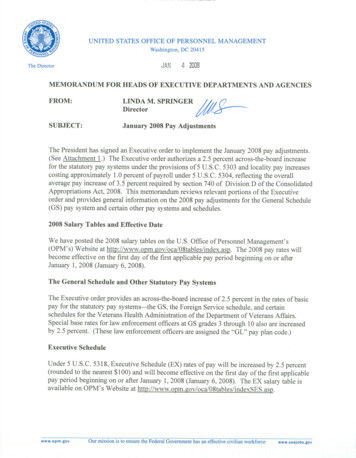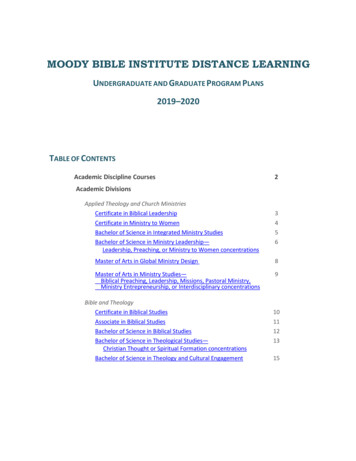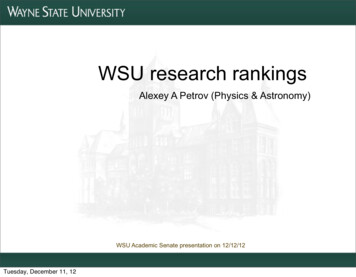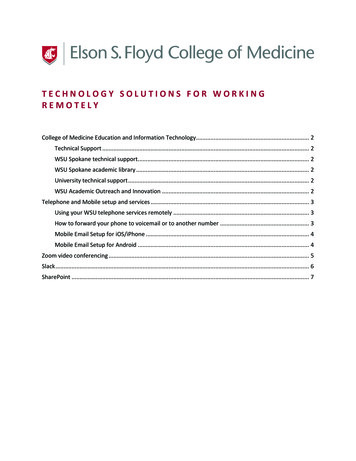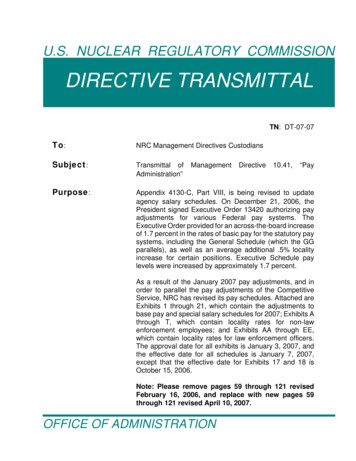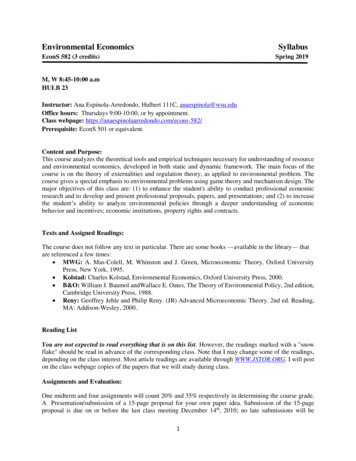
Transcription
Environmental EconomicsSyllabusEconS 582 (3 credits)Spring 2019M, W 8:45-10:00 a.mHULB 23Instructor: Ana Espinola-Arredondo, Hulbert 111C, anaespinola@wsu.eduOffice hours: Thursdays 9:00-10:00, or by appointment.Class webpage: isite: EconS 501 or equivalent.Content and Purpose:This course analyzes the theoretical tools and empirical techniques necessary for understanding of resourceand environmental economics, developed in both static and dynamic framework. The main focus of thecourse is on the theory of externalities and regulation theory, as applied to environmental problem. Thecourse gives a special emphasis to environmental problems using game theory and mechanism design. Themajor objectives of this class are: (1) to enhance the student's ability to conduct professional economicresearch and to develop and present professional proposals, papers, and presentations; and (2) to increasethe student’s ability to analyze environmental policies through a deeper understanding of economicbehavior and incentives; economic institutions, property rights and contracts.Texts and Assigned Readings:The course does not follow any text in particular. There are some books —available in the library— thatare referenced a few times: MWG: A. Mas-Colell, M. Whinston and J. Green, Microeconomic Theory, Oxford UniversityPress, New York, 1995. Kolstad: Charles Kolstad, Environmental Economics, Oxford University Press, 2000. B&O: William J. Baumol andWallace E. Oates, The Theory of Environmental Policy, 2nd edition,Cambridge University Press, 1988. Reny: Geoffrey Jehle and Philip Reny. (JR) Advanced Microeconomic Theory. 2nd ed. Reading,MA: Addison-Wesley, 2000.Reading ListYou are not expected to read everything that is on this list. However, the readings marked with a "snowflake" should be read in advance of the corresponding class. Note that I may change some of the readings,depending on the class interest. Most article readings are available through WWW.JSTOR.ORG. I will poston the class webpage copies of the papers that we will study during class.Assignments and Evaluation:One midterm and four assignments will count 20% and 35% respectively in determining the course grade.A Presentation/submission of a 15-page proposal for your own paper idea. Submission of the 15-pageproposal is due on or before the last class meeting December 14th, 2010; no late submissions will be1
accepted. A brief oral presentation of the proposal is also required and will be scheduled for the last twoweeks of the semester. Midterm and final makeup’s are possible only if reasons beyond the student's controlcan be verified. Please note that all items in this syllabus are subject to change at the discretion of %Homework335%Written Proposal120%Oral Presentation225%Total100%Grading Scale:AAB BBC C95-10085-9480-8470-7965-6960-6455-59CD DF50-5445-4940-440-39Tentative Class Calendar and Topics:DateJanuary 7thJanuary 9thJanuary 14th – 16thJanuary 21stJanuary 23rdTopicAssignmentExternalities:– Kolstad CH 5*– MWG CH 11*– B&O CH 4*– R. Coase (1960), The Problem of Social Cost, Journal of Law and Economics 3, 1-44.– Karl-Goran Maller (1989), The Acid Rain game, Valuation Methods and Policy Making inEnvironmental Economics (Studies in Environmental Science 36) (Elsevier), 231–52 *– Oxoby R. and J. Spraggon (2009), Game Theory For Playing games: Sophistication in aNegative Externality Experiment, Economic Inquiry, Forthcoming.– Erik T. Verhoef (1999), Externalities, In: J.C.J.M. van den Bergh (ed.), Handbook ofEnvironmental and Resource Economics Edward Elgar, Cheltenham, 197-214– Hal R. Varian (1994), A Solution to the Problem of Externalities When Agents Are WellInformed, The American Economic Review, Vol. 84, No. 5, pp. 1278-1293* Montero, J.-P. (2008), A simple auction mechanism for the optimal allocation of thecommons, American Economic Review, March.* Spulber, D. (1988), Optimal environmental regulation under asymmetric information,Journal of Public Economics 35, 163-181.* Ana Espinola-Arredondo (2008), Green Auctions: A biodiversity study of mechanismdesign with externalities, Ecological Economics, vol. 67(2), pages 175-183– Tracy Lewis (1996), Protecting the Environment When Costs and Benefits are PrivatelyKnown, Rand Journal of Economics 27 (4), 819-847.Martin Luther King Jr Day--ALL UNIVERSITY HOLIDAYContinuedHW 1 (due 01/30)IntroductionEfficiency and Markets– Kolstad CH 4 *– Reny CH 7, pp 280-302 *2
January 28thJanuary 30thFebruary 4thFebruary 6thFebruary 11thFebruary 13thFebruary 18thFebruary 20thContinuedContinuedProperty Rights– Kolstad CH 6*– Kolstad CH 5*– Stergios Skarperdas (1992) Cooperation, Conflict, and Power in the Absence of PropertyRights, The American Economic Review, Vol. 82, No. 4, pp. 720-739*– Oxoby R. and J. Spraggon (2008), "Mine and Yours: Property Rights in Dictator Games."Journal of Economic Behavior and Organization, 65, pp.703-713.– J. Farrell, "Information and the Coase Theorem," Journal of Economic Perspectives, 1 (Fall1987), 113-129.*ContinuedPigovian Fees– Kolstad CH 7*– R. D. Horan, J. S. Shortle and D. G. Abler (1998), Ambient taxes when polluters havemultiple choices, Journal of Environmental Economics and Management 36– K. Segerson (1988), Uncertainty and incentives for nonpoint pollution control, Journal ofEnvironmental Economics and Management 15, pp. 87–98.– A. Xepapadeas (1991), Environmental policy under imperfect information: Incentives andmoral hazard, Journal of Environmental Economics and Management 20, pp. 113–126.– Pezzey, W. (2003), Emission Taxes and Tradable Permits:A Comparison of Views on LongRun Efficiency, Environment and Resource Economics, 26(2), 329-342– E. Sheshinski,(2002) "Note on Atmosphere Externality and Corrective Taxes," DiscussionPaper 84, Center for Rationality and Interactive Decision Theory, Hebrew University,Jerusalem.ContinuedPresident's Day--CLASS HOLIDAYEnvironmental Policy– Kolstad CH 8 and 9*– Oates et al. (1989), The Net Benefits of Incentive-based Regulation: A case study ofenvironmental standard Setting, American Economic Review 79, 1233-1242.*– Kolstad, Ulen and Johnson (1990), Ex ante regulation vs. ex post liability for harm:Substitutes or complements? American Economic Review *.– Cropper, M. y W. Oates (1992) “Environmental Economics: A Survey”, Journal ofEconomic Literature– Montgomery, D. (1972), Markets in licenses and efficient pollution control programs,Journal of Economic Theory 5, 395-418.February 22ndAdverse Selection and Mechanism Design* B&O, ch. 5.* Kolstad, ch. 10.* Weitzman, M. (1974), Prices vs. Quantities, Review of Economic Studies 41(4), 477-91.* Roberts, M.J. and M. Spence (1976), Effluent Charges and Licenses Under Uncertainty,Journal of Public Economics 5, 1976, 193-208.* Evan Kwerel (1977), To Tell the Truth: Imperfect Information and Optimal PollutionControl, Review of Economic Studies 44 (3), 595-601.* Wilson, R. (1979), Auctions of Shares, Quarterly Journal of Economics 93, 675-89.* Varian, H. (1994), A solution to the problem of externalities when agents are well informed,American Economic Review 84, 1278-1293.* S. Baliga and E. Maskin (2002), Mechanism design for the environment, mimeo, KellogNorthwestern University.* Dasgupta, P., P. Hammond and E. Maskin (1980), On imperfect information and optimalpollution control, Review of Economics Studies 47, 857-860.February 27thStudent Presentations3HW 2 (due 02/13)HW 3 (due 03/06)HW 4 (due 04/08)
March 4thMarch 6thMarch 11th March 15thMarch 18thMarch 20thMarch 25thMarch 27thApril 1stApril 3rdApril 8thApril 10thContinued (Student Presentations)Continued (Student Presentations)Spring BreakContinued (Student Presentations)Continued (Student Presentations)Continued (Student Presentations)Game Theory and the Environment* Barrett, S. (1994a) Self-enforcing international environmental agreements, OxfordEconomic Papers 46 , 878–94.* Barrett, S. (1999) A theory of full international cooperation, Journal of Theoretical Politics11 , 519–41.* Espinola-Arredondo, A. (2009) Free-riding and Cooperation in Environmental games,Journal of Public Economic Theory, Volume 11, Issue 1, Pages 119-158* Folmer, H., P. Van Mouche, S. Ragland (1993) Interconnected games and internationalenvironmental problems, Environmental and Resource Economics 3 , 313–35.* Hanley, N., H. Folmer (1998) Game Theory and the Environment. Edward ElgarPublishing.– Hoel, M., K. Schneider (1997) Incentives to participate in an international environmentalagreement, Environmental and Resource Economics 9 , 153–170.– Schelling, T. (2006) Strategies of Commitment and Other Essays, Cambridge , MA :Harvard University Press.– Whalley, J. (1991) The interface between environmental and trade policies, The EconomicJournal 101 , 180–189– Hotelling, H. (1931) "The Economics of Exhaustible Resources," Journal of PoliticalEconomy, 39, pp. 137-175– Dutta, P. and R.K. Sundaram (1993) "The Tragedy of the Commons?" Economic Theory,3, pp. 413-426– Apesteguia, J. (2006) "Does Information Matter in the Commons? ExperimentalEvidence," Journal of Economic Behavior & Organization, 60, pp. 55-69. *– Levhari, D. and L.J. Mirman (1980) "The Great Fish War: An Example Using a DynamicCournot-Nash Solution," Bell Journal of Economics, 11, pp. 322-334.ContinuedContinuedContinuedEmpirical Analysis of Regulatory Performance– Joskow, P., R. Schmalensee, and E.M. Bailey (1998), The market for sulfur dioxideemissions, American Economic Review 88, 669-685.*– Greenstone, M. (2002), The impacts of environmental regulations on industrial activity:Evidence from the 1970 and 1977 Clean Air Act Amendments and the Census ofManufacturers, Journal of Political Economy 110, 1175-1219.*– Montero J.P. , Sánchez J.M. y R. Katz (2002), A Market Based Environmental PolicyExperiment in Chile, Journal of Law and Economics 45.*– Davis, L. (2008), The Effect of Driving Restrictions on Air Quality in Mexico City, Journalof Political Economy 116, 38-81.*– Fullerton and Kinnaman (1996), Household responses to pricing garbage by the bag,American Economic Review 86, 971-984.– O’Ryan, R. (1995), Cost-effective policies to improve urban air quality in Santiago, Chile,Journal of Environmental Economics and Management 31, 302-313.– Foster V. and Hahn, R. (1995), Designing More Efficient Markets: lessons from LosAngeles Smog Control, Journal of Law and Economics, 38, 19-48.– Schmalensee R., et al, (1998), “An Interim Evaluation of Sulfur Dioxide EmissionsTrading”, Journal of Economic Perspectives 12, 53-68.4
April 15thApril 17thApril 22ndApril 24thApril 29th– Stavins, R. (2000), “Experience with Market-Based Environmental Policy Instruments”,Handbook of Environmental Economics, eds. Karl-Göran Mäler and Jeffrey Vincent.Amsterdam: Elsevier Science.Student PresentationsStudent PresentationsStudent PresentationsStudent PresentationsSubmission of Written ProposalsDisability Resource Accommodation:Reasonable accommodations are available for students who have a documented disability. Please notify theinstructor the first week of class of any accommodations needed for the course. Late notification may causethe requested accommodations to not be available. All accommodations must be approved through theDisability Resource Center (DRC) (Washington Building, Room 217). Please stop by or call 509-335-3417to make an appointment with a disability specialist http://www.drc.wsu.edu.Academic Honesty:WAC 504-25-015. Academic dishonesty, such as cheating, plagiarism, fabrication, and fraud, is prohibited.See http://www.conduct.wsu.edu/default.asp?PageID 343 for more information and specific definitions ofacademic dishonesty.As an institution of higher education, Washington State University is committed to principles of truth andacademic honesty. All members of the University community share the responsibility for maintaining andsupporting these principles. When a student enrolls in Washington State University, the student assumes anobligation to pursue academic endeavors in a manner consistent with the standards of academic integrityadopted by the University. To maintain the academic integrity of the community, the University cannottolerate acts of academic dishonesty including any forms of cheating, plagiarism, or fabrication.Washington State University reserves the right and the power to discipline or to exclude students whoengage in academic dishonesty. To that end, the University has established the following rules definingprohibited academic dishonesty and the process followed when such behavior is alleged. These rulesincorporate Washington State University’s Academic Integrity Policy, the University-wide documentestablishing policies and procedures to foster academic integrity. This policy is applicable to undergraduateand graduate students alike, as it pertains to dishonesty in course work and related academic pursuits. Incases of dishonesty in research and original scholarship, the University’s Policy and Procedural Guidelinesfor Misconduct in Research and Scholarship may take precedence over the policies and procedurescontained herein.Academic dishonesty includes cheating, plagiarism, and fabrication in the process of completing academicwork. These standards should be interpreted by students as general notice of prohibited conduct. Theyshould be read broadly, and are not designed to define misconduct in exhaustive forms.Campus Safety Plan5
Can be found at http://safetyplan.wsu.edu and http://oem.wsu.edu/emergencies, contains a comprehensivelisting of university policies, statistics and information related to campus safety, emergency managementand the health and welfare of the campus community.Disclaimer: This syllabus is subject to change to facilitate instructional and/or student needs.6
environmental problems, Environmental and Resource Economics 3 , 313-35. * Hanley, N., H. Folmer (1998) Game Theory and the Environment. Edward Elgar Publishing. - Hoel, M., K. Schneider (1997) Incentives to participate in an international environmental agreement, Environmental and Resource Economics 9 , 153-170.
